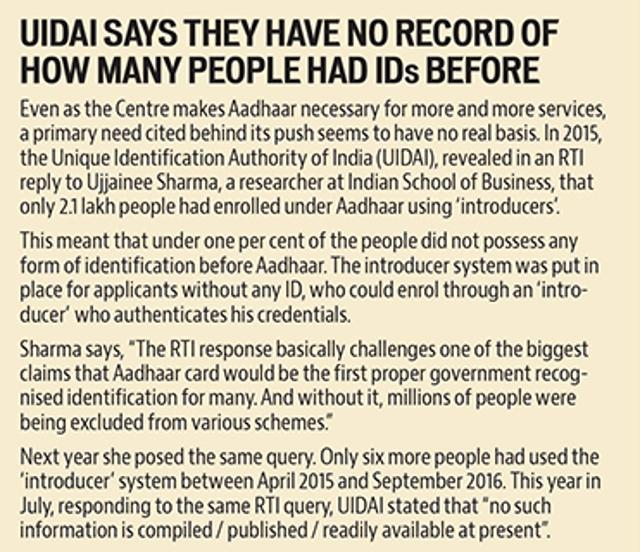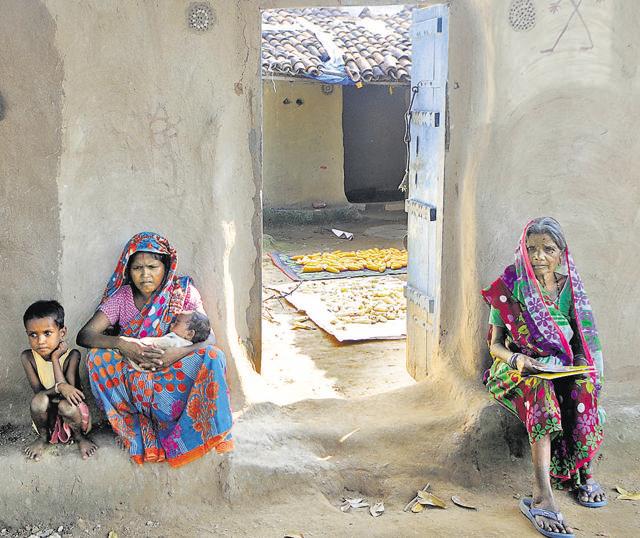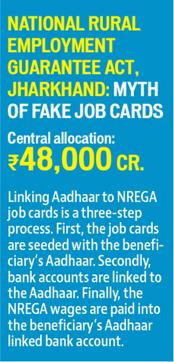Lost in transition: Has linking Aadhaar to government welfare schemes made it difficult for beneficiaries to avail of aid?
Aadhaar is now compulsory for 87 government welfare schemes. HT reviews how this decision is working on the ground for two of the biggest schemes of this kind
What does Anita, a slum dweller in Delhi, have in common with Muniya Devi, a villager in Jharkhand? They subsist on two of the government’s biggest social welfare schemes – the National Food Security Act (NFSA) and the Mahatma Gandhi National Rural Employment Guarantee Act (MGNREGA, also known as NREGA) respectively.

But both face exclusion from these rights guaranteed under law because of Aadhaar. Not because they don’t have an Aadhaar card but due to problems stemming from linking it to welfare schemes.
Last year, after the passing of the Aadhaar (Targeted Delivery of Financial and Other Subsidies, Benefits and Services) Act, the government has made Aadhaar compulsory for at least 87 government welfare schemes – from pensions and scholarships to fertilizer and LPG subsidy.
The main argument is that Aadhaar provides a foolproof mechanism to check fake or ghost beneficiaries, reducing corruption and saving money.
Through ground reports, RTI responses and court documents, HT reviewed the impact of this linkage to the schemes which the Centre spends most on – the NFSA, which provides subsidised ration to poor households and NREGA, which guarantees employment to rural households for at least 100 days a year.

The Missing Link To Getting Food Security
In April 2015, Tosif Khan, a fair price shop owner selling subsidised ration under the NFSA received a sleek Point of Sale machine from the Delhi food and civil supplies department. The government was testing new Aadhaar-enabled biometric machines and Khan’s shop in Chandni Chowk had been selected amongst 42 shops for the pilot project. Through the machines, the beneficiaries would get ration after their biometrics matched with those given for Aadhaar. The government claimed it would automatically weed out ghost or fake beneficiaries.
But Khan’s machine developed a snag and stopped charging about a year later. On September 8, he sent a one-line email to the central district’s assistant commissioner of food department, saying, “Sir, device mein charging nahi ho rahi hai” (Sir, the device is not charging). The reply came the same day. The terse email read: “To hum kya karein” (So what should we do?).
After that Khan went back to using manual entries for providing ration – exactly the opposite of what the pilot project was testing.


He wasn’t the only one to face problems. Another shop-owner (speaking on the condition of anonymity) who runs a fair price shop near the Delhi airport told HT that lack of cellphone network was a perpetual problem in operating the machine.
In his case, when the machine developed a fault, the government directed him to the manufacturing company. The company in turn told him that their contract was over and hence they were not responsible. He too, then went back to manual entries.
The failure rate of the government pilot was more than 50 per cent – of the 42 shops where the machines were tested, only 18 remained till the end. Yet, the Delhi government is about to roll out mandatory use of machines at all fair price shops from November.
Delhi Food Commissioner, KR Meena dismissed these as standalone examples. He said there was not enough awareness within the department since the pilot was limited. “Last time, our contract with the company was only for a year, so there were maintenance issues with the machines. This time we have a five-year contract with BHEL. They will be required to provide repair work within two hours of any complaint,” he said.
But the Delhi Rozi Roti Adhikar Abhiyan says that unreliable machines point to a bigger problem – people who don’t get ration due to biometric failures or mismatch.
They estimate that in Delhi about 12 per cent of eligible beneficiaries may have been excluded in one year because of biometric failure. But the state government says they have no data on it.
To address the problems posed by the machines tested, the government is banking on more advanced ones. Meena says, “With the new machine, if fingerprint biometrics don’t match, there will be an iris scan mechanism. If even that doesn’t work, then a mobile-based pin system will be used where a one-time password will be sent to the beneficiary’s phone number.”
Slamming this, Anjali Bhardwaj of the Delhi Rozi Roti Adhikar Abhiyan, says reliance on untested technology to curb corruption is misplaced. “The pilot of the Delhi government showed several problems – including network connectivity, biometric failures and without explaining how these issues have been addressed they are scaling it up.”
But exclusion is not caused by machine failures alone. Thirty-year-old Anita, living in a slum in south Delhi has spent three years trying to get ration for her autistic son, Nitin. The nine-year-old child did not have an Aadhaar card when Anita applied.
She is unable to take up a job as Nitin cannot be left alone. The family depends on the erratic income of her husband who works as a labourer and monthly subsidised food grains. Anita made three trips to an Aadhaar enrolment centre before the child could give his biometrics.
“He used to get scared of the machine and run away. But after all that effort when the Aadhaar card came, I was told his name still cannot be added to the ration card as the quota was full,” says Anita as she tries to hold Nitin in her lap. She was also unable to avail disability benefits for Nitin due to lack of Aadhaar.
Several such stories came to light when the Delhi Rozi Roti Adhikar Abhiyan took the government to court in February this year against Aadhaar being made mandatory for ration.
The Delhi High Court in September directed the government to start providing ration to Anita’s children, along with 40 other affected families.
A relieved Anita asks, “Gareeb ka khana ek card ki wajah se lekar sarkar ko kya fayda hua?” (How has the government benefited by taking food from a poor person because of a card?)

Aadhaar: A Hurdle To Getting Employment?
Muniya Devi, 23, from Bari village, about 90 km away from Ranchi, gave birth to her third child – Lalchand, three months ago. But within a week , she was making a train journey with her husband and children to neighbouring Daltonganj to find work.
While she and her husband broke stones at a construction site for ~200 a day, her eldest son looked after the youngest.They stayed there for two months to earn enough to survive the next few. “There was no other work in the village,” she says quietly. For unlettered and landless families living in remote villages, NREGA work has often been a lifeline. But when that dries up, they must move out.
With Lalchand slung on her tiny waist, she shows me her NREGA job card. According to the manual entry on the card, she last worked in December 2012 under the scheme. But it wasn’t only the lack of work that was the problem. Muniya’s card had been struck off the NREGA list in 2014 and the reason listed was “wants to surrender card”. Muniya stares perplexedly when I tell her. She has no idea when or how that happened. “We are not educated so I don’t know all this,” she mumbles.

James Herenz, of Jharkhand NREGA Watch, alleges that large-scale deletions happened when the state started linking Aadhaar with job cards. “To complete 100 per cent seeding of job cards with Aadhaar, those who didn’t have Aadhaar were simply struck off the list citing various reasons.” Almost two dozen villagers HT met from Bari had their names struck off with no knowledge of it. Total deletions from the village stood at 417. These deletions are important as the Centre has often cited that Aadhaar seeding with NREGA has helped to weed out fake or ghost beneficiaries. But ground reality suggests that many who lost their job cards were eligible for the scheme.
In April 2017, it was reported that the government had deleted over 90 lakh ‘fake’ job cards nationally. Verification involved checking the Aadhaar numbers of beneficiaries. But when economist Jean Dreze filed an RTI with the rural development ministry, only four per cent of the deletions turned out to be fake. Reetika Khera, economics professor at IIT Delhi says, “The focus on Aadhaar-linking in NREGA is a diversionary tactic, ignoring real problems such as difficulty in getting work, delayed wages and low wages.”
For Jharkhand, the RTI numbers show a similar trend. Of the 1.08 lakh deletions, only 2,675 were fake and 13,455 were duplicate. State NREGA commissioner, Siddharth Tripathi admitted that there were problems in the initial seeding exercise. “At that time there was no verification, only collection of Aadhaar data.” To rectify the problems of the first, the state launched a second drive. “Last August, we spent two months linking both Aadhaar and bank accounts to job cards. We helped people who didn’t have them to make new ones. Then, we ran a campaign in every ward to verify these,” says Tripathi.
The new exercise has resulted in deletion of 3.5 lakh cards. However, the department was unable to provide a breakdown of how many of these were fake and how many were deleted for other reasons.
Khera thinks the problem lies elsewhere, “Aadhaar can reduce ‘identity fraud,’ but the government has failed to honestly answer whether identity fraud is the disease that ails welfare schemes. Welfare needs Aadhaar like a fish needs a bicycle.”
Catch every big hit, every wicket with Crickit, a one stop destination for Live Scores, Match Stats, Infographics & much more. Explore now!
See moreGet Current Updates on India News, Budget 2024, Weather Today along with Latest News and Top Headlines from India and around the world.




